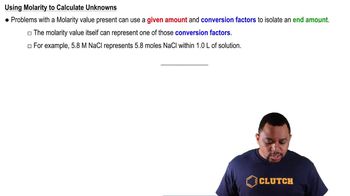Here are the essential concepts you must grasp in order to answer the question correctly.
Molarity
Molarity (M) is a measure of concentration defined as the number of moles of solute per liter of solution. It is a crucial concept in preparing solutions, as it allows chemists to quantify how much solute is dissolved in a given volume of solvent. In this case, a 0.075 M solution means there are 0.075 moles of potassium ions (K+) in every liter of the solution.
Recommended video:
Dilution
Dilution is the process of reducing the concentration of a solute in a solution, typically by adding more solvent. When preparing a specific molarity, understanding how to dilute a more concentrated stock solution to achieve the desired concentration is essential. The dilution formula, C1V1 = C2V2, helps calculate the volumes needed to achieve the target concentration.
Recommended video:
Preparation of Aqueous Solutions
Preparing an aqueous solution involves dissolving a solute in water to create a homogeneous mixture. For the given problem, one would need to accurately measure the required amount of potassium salt (like KCl) that provides the desired K+ concentration when dissolved in water. This process requires precision in measuring both the solute and the final volume of the solution.
Recommended video:
Types of Aqueous Solutions
 Verified step by step guidance
Verified step by step guidance


